When it comes to embroidery stitches, there’s not a whole lot that’s new under the sun. Pretty much all embroidery stitches build off what’s come before. Embroidery has been around for a long, long time, after all, so there’s a lot that has come before.
Still, occasionally, I like to explore ideas for embroidery stitches that don’t necessarily exist in the wide, well-known deposit of embroidery stitch collections.
For example, I was contemplating edging stitches for finished items. It started with this pin cushion, which I edged in one of my favorite stitches – one that I’ve used numerous times to edge finished items.
I got to thinking that maybe I’d play around with some ideas for other methods of edging. And while there are loads of stitches out there that can be used for edging an item, I started putting together in my mind possibilities for variations and approaches that I’ve not tried.
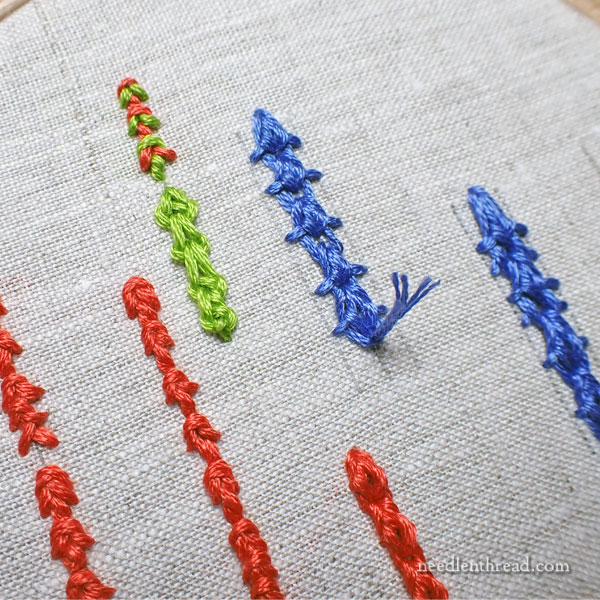
This led me to daydreaming about the movements of different embroidery stitches and what would happen if I mixed up or altered the principle movements of already-tried stitches.
Whenever I start that kind of daydreaming, the next thing I know, I’ve gotten out a scrap of fabric, a hoop, some threads, and I’ve started playing around.
And then the morphing begins.
One idea leads to another. In the end, I haven’t actually resolved anything in particular as far as a single stitch is concerned, but I’ve planted the seeds for possibilities.
Would you like to come on a stitch-morphing journey with me?
Come on! I’ll show you how it goes!
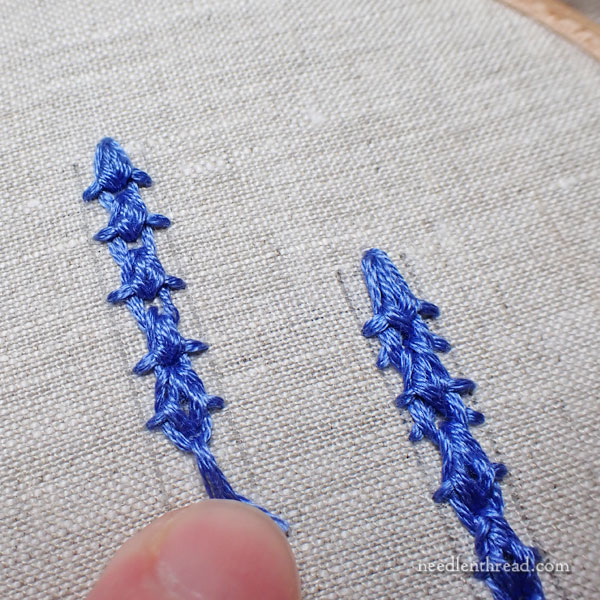
I started here.
Using a full six strands of floss, I always work Big when I’m playing around like this. I want to be able to see clearly the movements of the stitch and how and why and wherefore, as far as the movements go. So no tiny delicate threads at this point! I just grab scrap thread and start playing.
When I started, I had in mind that I wanted a stitch that branches to each side. If I’m playing with edging, I like the idea of a stitch that grips both sides of whatever is being edged, with a heavy line or braid or twist or something down the middle.
So with these blue stitches I just tried different movements of joining and looping and chaining and knotting over two “arms” that extend out from a middle.
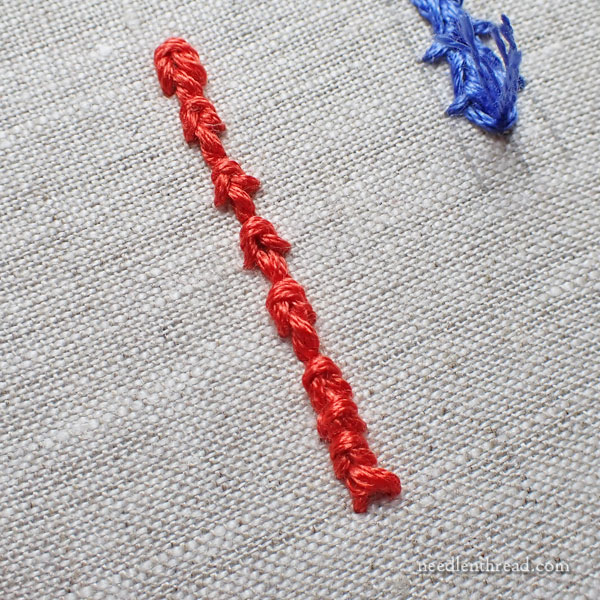
That led me to this next line of stitches, wherein I switched up the way I looped the threads and passed them under the arms. I also shortened the side arms, to make the line a little more compact.
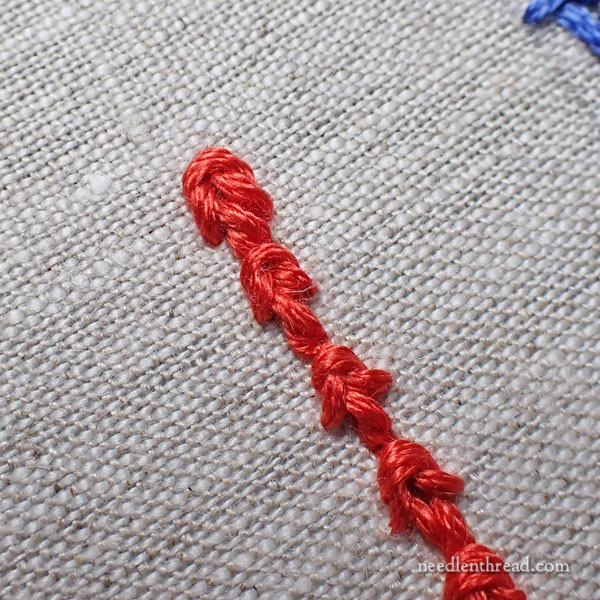
I kind of like the little twisty bits on this.
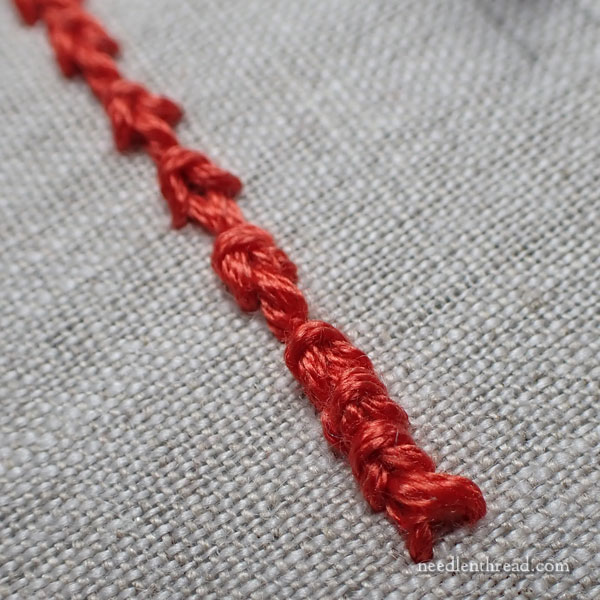
Towards the end of the line, I started working the stitches a little smaller and closer together, but then the whole line started looking muddled.
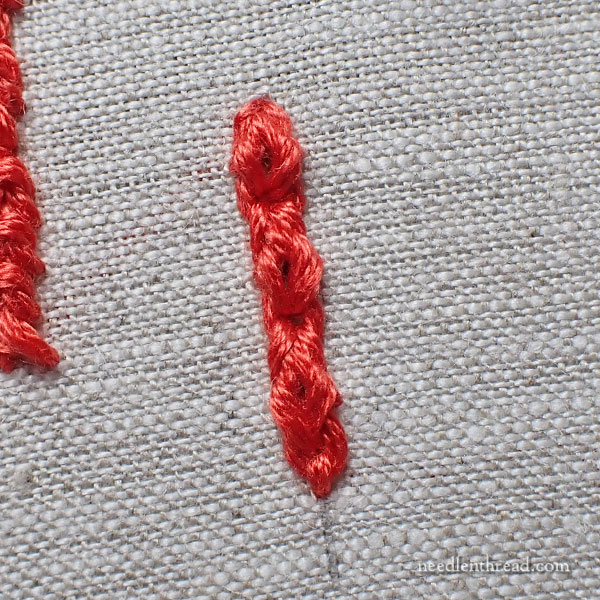
Then, I went back to the same format as the original blue stitches, but I reduced the length of the side arms so that they would not form visible “barbs.”
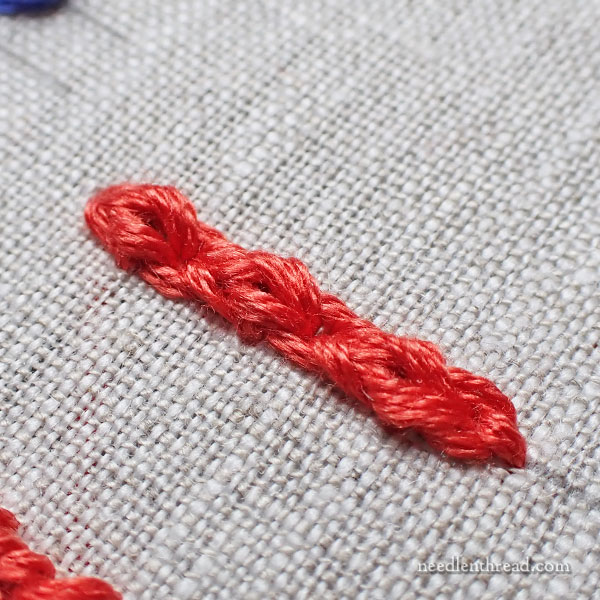
I kind of like this! It reminds me a little of the icing edge on a decorated cake.
(It’s always problematic when my embroidery starts reminding me of food. Especially cake. I like cake.)
I’m going to have to try this approach with a different thread, I think – like a perle cotton, with a little more twist to it, just to see how the difference in thread plays with the look of the stitch.
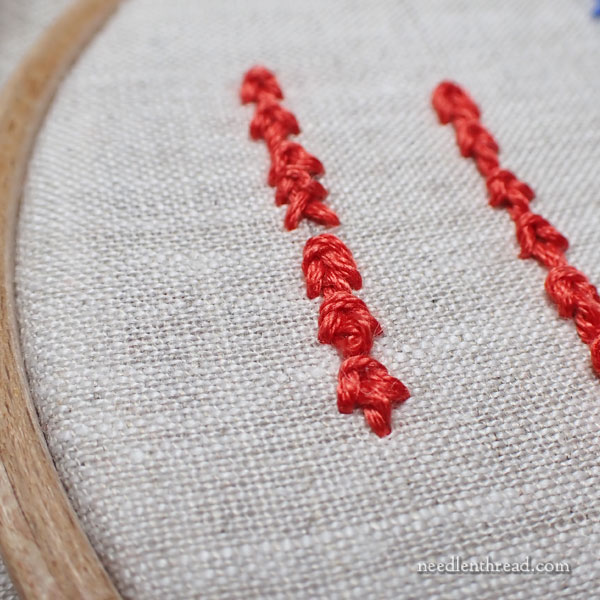
Then, I went back to the original red stitch line, and tried a slightly different approach by exaggerating some of the twisted elements.
Mmmmm… not quite doing it for me. There are aspects I like, but aspects I don’t. It looks better as an individual stitch, I think, rather than a line stitch. And I wonder if it already exists as an individual stitch? I may have seen this one somewhere before.
Anyway, while I was contemplating this one and exploring it, I wondered if it would be possible to start with a foundation of separate stitches, and then go back and work the twisty bits over the foundation lines.
And then I wondered if it would work as a two-colored stitch.
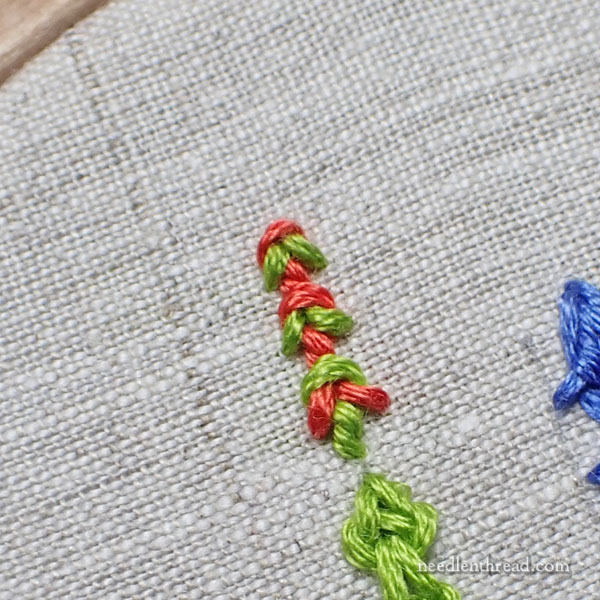
So I tried that, with the idea of a little line of buds in mind.
Meh. Not sure about that. But it is something I will explore a little farther. A different idea has morphed in my head, that I’ll need to try out.
But in the meantime, the dual-colored approach landed me with a different idea on the stitch altogether, which led to this:
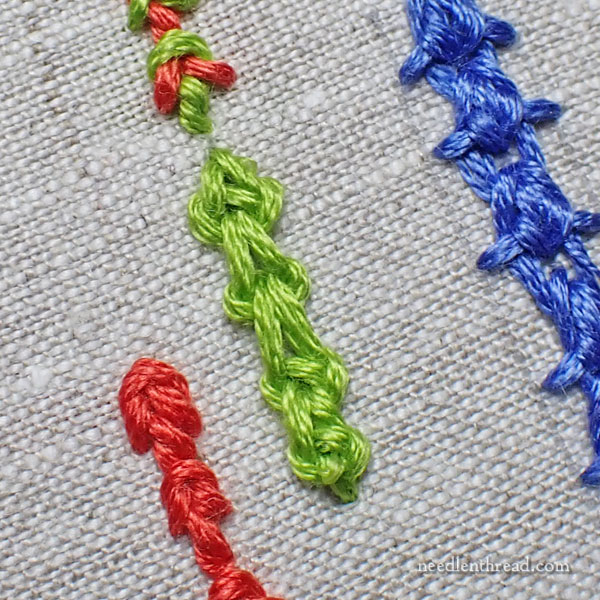
…which reminds me of a cross between Spanish Knotted Feather Stitch (without the off-set feather) and Braid Stitch (cable plait stitch).
So I thought about that one. I don’t not like it.
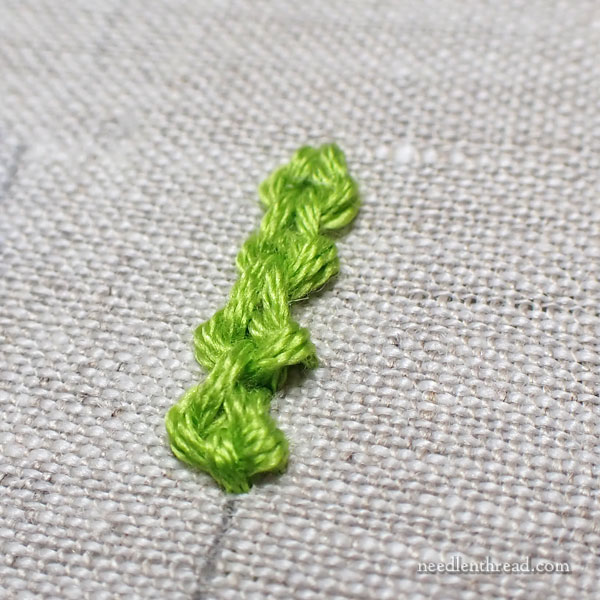
I decided to try it again in isolation, with a variation. I think I like it. It’s also something I’ll explore further.
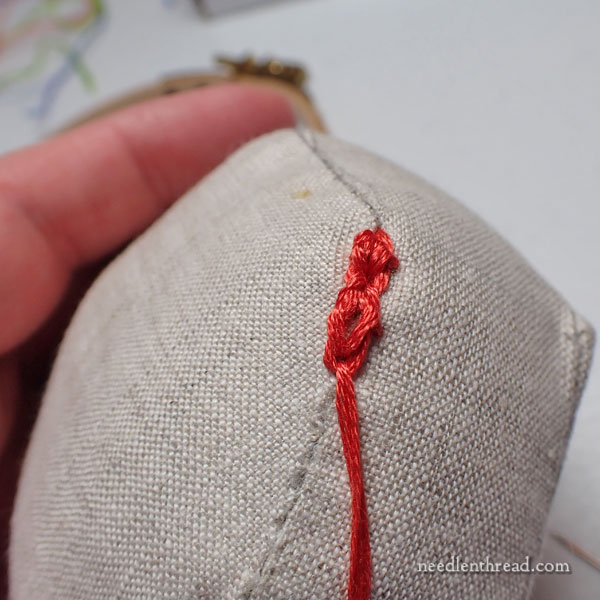
I decided to try my icing stitch on the edge of a form – the original form made up to test the pincushion construction – and I discovered a couple things.
One, I like the look, but two, it is a difficult stitch to work on an edge, because there’s so much back-and-forth movement on it.
I must explore further.
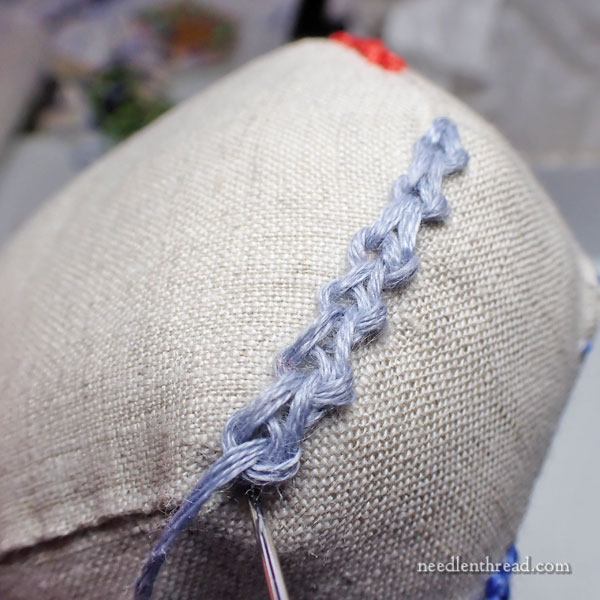
Then I tried the morphed-knotted-non-feathered-cable-plait-stitch thingy on an edge, using a Most Unfortunate Piece of scrappy thread. Despite the (s)crappy thread, I got a good idea of what it would look like on an edge.
I like it somewhat. It deserves more exploration, too.
So that’s how I explore stitches. Ideas just morph from one to another. I will go back now and try out variations with different threads, and see what I can work up.
If something comes about that I find particular useful or fun to stitch, I’ll work out step-by-step instructions and share them with you. Then, we can put our collective brains together to see if it’s been done before and has a name. If it doesn’t, we can name it and add it to the general repertoire.
Fun stuff!







Ooooh! I really like the very first blue one, the one that’s kind of spiky. Any chance you could show or tell us how it was done? Cheers, M
Oh YUM! Love your explorations! Where you go, we will follow!!!
That’s fascinating Mary! My inexperienced stitching brain boggles a little at the process (I’m still getting to grips with regular repertoire stitches) but it’s interesting seeing how you play around and step into uncharted waters to create something unique. I look forward to seeing what you settle on eventually. 🙂
This is fascinating to me. And I am super excited about the pin cushion stitch along.
Ooo, I know! The Corbet Cable!
What about playing with Floche? Wouldn’t that make seeing elements of the stitches easier?
Floche is a very fine, thin, soft cotton thread. It’s always a little more difficult to see the movements of the stitch with fine threads, which would require keeping the stitch very small to see the effect of it proportionately.
While you are thinking about stitches to cover an edge, I have been thinking about stitches to bind 2 edges together. I am not a big fan of the Nun’s Stitch. I do not like the frazzled threads left behind on the cut edge. The ladder stitch can be difficult to see – especially if using thread the same color as the fabric.
I have heard about a Nun’s Stitch variation worked without cutting the outside edge. Stitching thru folded fabric (2 layers) – BUT I could not figure out how to corner with folded fabric. I would be very interested if anyone has heard of this or has directions.
Stay Warm,
Lois
I love the green and pink if the pink were just the round bits. The blue with barbs is fabulous. Please add it to your stitch tutorial. Love this little project.
Very interesting reading about the different stitches you are exploring for edging. So far I have always used whipped chain or Palestrina st but I now see that there are many more sts that would make great edges. Thank you I will now try some different some.
Wow, I loved the exploration of stitches. The first blue one really excited me. Too fun.
Those look lovely 🙂
I’ve only ever invented new stitches by accident, i.e., by messing up the way the stitch was supposed to be done… 😉
I am soo tempted to take some of your ideas and tweak them myself now I’ve seen where you were going. Also, if you don’t have, you might like, “New stitches for needlecraft” by Edith John, Dover pub 1968. Takes known stitches and shows them in different uses and forms etc. I wouldn’t part with my copy bought 2nd hand.
This was so, so very informative. As usual, your explanation of what you were thinking about and the pictures to show us is, as usual, the very best.
Can’t wait to see what you think the best iteration will be.
I do love the blue, but that icing stitch is
I love your original blue line. It reminds me of barbed wire or goathead burr… Perfect for edging something Australian
I very much like the blue stitchline on the left. It could just connect the two sides of the edge a little bit like a Parisienne stitch in Applique work,
Can you name or explain this stitch in more detail?
Thx
Wonderful instructions, thanks Mary. I love this pincushion.
Interesting looks. My fave is the darker blue with the barbs.
I read your blog every day and am always amazed, but I always learn something from you! Thank you for your inspiration, the pincushion looks like a project I will want to take part in,
With as many needlework stitches that are known, I wonder how many more have been lost. Those little doodles that never made it into general use, those left behind by loss of so called “old fashioned” knowledge that never got passed on, etc.
Do you pick up any floss color that’s handy for your doodles, or do you pull out colors that are less favored for projects? And would perle cotton work for doodles? I have a lot of that in colors I don’t think I’ll ever use. I like your little doodles. And I second the name Corbet Cable if it is a new stitch!
I have a basket that has unlabeled leftover threads in it, that I use for demos or experimenting, etc. There’s all kinds of threads in there – perle cottons, regular floss, silk, wool, whatever. I’ll use any of it, depending on what I’m doing. I’ll definitely be trying these stitches with other threads, too. 🙂
I love the first blue stitch and I’m so excited to begin this project!
Stunning work – original – innovative within the tradition.
Great stuff!